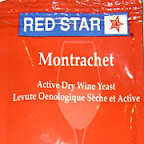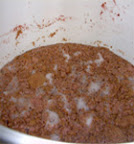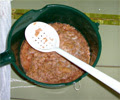Tips for Successful Backyard Grape Growing
Monday, May 09, 2011
By Jim Bruce
Growing grapes in the backyard or garden can be a rewarding experience. It can also be quite a failure if not done properly. Grapevines are perennial plants and will grow for years to come. There are a few things to consider before you just jump in and start planting your grapevines. Otherwise, mistakes made at planting will haunt you in the future.
Grapes need lots of sunshine. One of the biggest mistakes that the home gardener makes when growing grapes is to plant them in the shade under a tree or where they get shaded by houses most of the day. If you watch wild grapevines grow, you will notice they make all efforts to climb trees and shrubs to get into the daylight. Without proper sunlight, proper ripeness cannot be obtained. Be sure the spot you choose has good sun most of the day.
A second mistake that many home gardeners make is to not take into account the grape variety's growth habit and vigor. These two factors come into play when planting the grapevine and deciding on how to trellis the vine.
Vigorous varieties need lots of space. You can find out how vigorous a variety is by consulting your local nursery where you bought your vines. Vigorous varieties need eight feet between vines when planting. Less vigorous varieties can be planted closer at six feet between vines. Very low vigor vines can be planted as close as four feet.
Growth habit determines the trellis type and how the grapevine will be trained and pruned. Grape varieties with a large portion of their ancestry coming from wild American species tend to droop. These are like the wild vines that grow to the top of small trees and shrubs then cascade downward during the summer. The gardener will find that it is best to mimic this natural growth.
Vines of this type will be trained to a high wire about six feet off the ground. The grapevines are pruned to two to four long canes each year. As the shoots grow each year from the canes left at pruning time, they will grow outward from each side and soon start drooping towards the ground, forming a curtain of leaves by the end of the growing season.
Many varieties have the European grape, V.vinifera, in their ancestry. The European grape varieties tend to have a more upright growth. These grape varieties need a more extensive trellis system. At least four wires are needed to contain them. The first wire is approximately three feet off the ground with the two additional wires at eight inch intervals above the bottom wire. The vines are trained to a trunk that extends to the bottom wire.
Two to four canes are pruned and tied to the bottom wire on each side of the trunk. As the shoots grow during the spring and summer they are tied straight up to the wires above. Once the shoots have reached approximately 16 inches above the top wire, they are cut off at the tips. This "hedging" prevents further growth and shading of the vine below.
Grapes need a good water supply when they are actively growing in the spring and summer. They should be watered at least once a week in areas of little rain. More often under droughty conditions. This watering shoud be continued until the berries begin to turn color. After coloring, watering is not needed and will in fact slow the ripening process. Once the leaves have fallen in the fall, one last large watering should be undertaken before the ground freezes to get the vines through the winter.
Perhaps the biggest mistake I see with home gardeners growing grapes is neglecting pruning the vines each year. This is a must! Without pruning the grapevine becomes an overgrown tangled mess. The grapevines overbear and the berries don't ripen properly. Disease sets in as the vine is over shaded and doesn't recieve drying winds. The vines will weaken over time and eventually die before their time.
Pruning removes 90-95% of the previous year's growth. It keeps the vines in balance and aids in controlling the crop and ripening the fruit. Pruning the grapevine is an art, not a science. Information on grapevine pruning can be obtained through your local Ag Extension agent. They have agricultural bulletins that detail the pruning process. You can also find comments at: http://www.ristcanyonvineyards.com/grapevine_pruning_and_training.html
Growing grapevines can be a nice hobby that will provide you and your family with fresh fruit or grapes to make wine with. Table grape varieties and wine varieties are distinct. Make sure you are planting the proper varieties for the wanted purpose. Home gardeners should also make sure that the varieties they are planting are adapted to their local climate. Some varieties cannot take cold winters, while others can tolerate freezing temperatures down to -25-30F.
Varieties that have American grape species in their ancestry can tolerate colder winters. Make sure you consult with your nurseryman to fit the variety you are planting to your conditions. The variety you choose must also be able to ripen in your climate. I see too many home gardeners planting varieties that take up to 170 days or more to ripen in areas that have only 150 days or less in their growing seasons.
If you are thinking of growing grapevines in your backyard or garden, be sure to consider the above factors before you start planting. Choose your grape varieties based upon what you plan to use them for, how they are adapted to the local growing conditions, and plan the trellis according to the variety's growth habit. I wish you all the luck in your endeavor.
Jim Bruce has been growing grapes since the mid-seventies under a range of growing conditions. His Rist Canyon Vineyards is a research project to aid others in growing grapes. More information can be found at http://www.ristcanyonvineyards.com
Article Source: http://EzineArticles.com/?expert=Jim_Bruce
http://EzineArticles.com/?Tips-For-Successful-Backyard-Grape-Growing&id=57486
Have New Posts From Making Homemade Wine and Beer Delivered To Your Email

 Follow Me On Twitter
Follow Me On Twitter



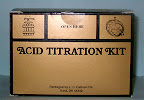
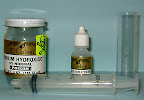




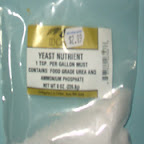


 Campden Tablets
Campden Tablets